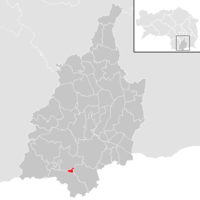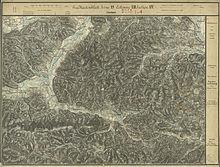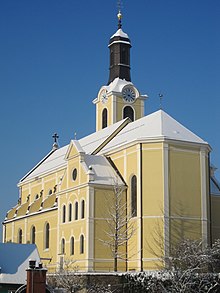Leutschach
|
Leutschach (former municipality) locality ( capital of the municipality ) Leutschach cadastral community |
||
|---|---|---|
|
|
||
| Basic data | ||
| Pole. District , state | Leibnitz (LB), Styria | |
| Judicial district | Leibnitz | |
| Pole. local community | Leutschach on the Wine Route | |
| Coordinates | 46 ° 40 ′ 1 ″ N , 15 ° 28 ′ 4 ″ E | |
| height | 352 m above sea level A. | |
| Residents of the village | 578 (January 1, 2020) | |
| Building status | 295 (2001 ) | |
| Area d. KG | 1.11 km² | |
| Post Code | 8463 Leutschach | |
| prefix | + 43/3454 (Leutschach) | |
| Statistical identification | ||
| Locality code | 15518 | |
| Cadastral parish number | 66020 | |
| Counting district / district | Leutschach (61054 000) | |
 Location of the former municipality in the Leibnitz district (as of 2014) |
||
| Source: STAT : index of places ; BEV : GEONAM ; GIS-Stmk | ||
Leutschach ( Slovenian Lučane ) is a village and a former market town with 567 inhabitants (as of October 31, 2013) in the Austrian state of Styria .
Since 2015, Leutschach has merged with Schloßberg , Eichberg-Trautenburg and Glanz an der Weinstrasse as part of the municipal structural reform in Styria to form the new large community of Leutschach an der Weinstrasse .
geography
The market town is the center of the southern Styrian hop-growing area ( hop growing in Styria ) and one of the centers of the southern Styrian wine-growing region ( Südsteirische Weinstrasse ). It is only a few kilometers from the Slovenian border.
geology
The rocks of Leutschach and the surrounding area belong to those of the Possruck and have been scientifically examined.
history
A Roman grave near Leutschach is evidence of the early settlement of the Pößnitz valley. This valley was as an alternate route to the dangerous Drautal an important traffic route towards the east . The castle Schmirnberg served for centuries as a protective fortress for migrating merchants and travelers.
In 1250 the name Leutschach was first mentioned in a document ("Liubschach"). 1458 awarded Emperor Friedrich III. the place the market law and its own jurisdiction.
The community of Leutschach emerged from the Trautenburg advertising district in 1850 and was much larger at the time. In 1882 it was divided into the communities of Markt Leutschach, Glanz, Schloßberg and Eichberg.
After the peace treaty of Saint-Germain , with which Lower Styria had to be ceded to the SHS state in 1919 , the entire region suddenly found itself in an isolated border situation, which led to economic backwardness. After the Second World War , the area bordered communist Yugoslavia , but this border (in contrast to the Austrian borders with Hungary and Czechoslovakia ) was never an impermeable " iron curtain ".
Parish history
Around the year 1200 there was already a first church in Leutschach, consecrated to St. Nicholas , the patron saint of merchants and travelers. In 1250 Leutschach was already its own parish after she was released from the Leibnitz parish. On January 2, 1427, Pope Martin V granted the Leutschach Church an indulgence.
In 1786 the parish was incorporated into the Graz-Seckau diocese , after having previously belonged to the Salzburg archdiocese . Since this year the pastor of Leutschach has also been appointed dean . The deanery was not abolished until the 1970s.
In 1816 the parish church was renovated under Dean Krofitsch; the side chapels were also added. In addition to his priesthood, Krofitsch also dealt with mathematics and architecture. He created an astronomical clock that is now considered one of the most valuable pieces in the Vienna Clock Museum .
In 1901 a church building association was founded to rebuild and enlarge the parish church, which had become too small. The foundation stone for the new church was laid on May 17, 1908; on April 29, 1911 the consecration of the new parish church was made.
In 1959 the parish church was renovated on the occasion of “500 years of the Leutschach market survey”. 1973–1977 a new interior and exterior renovation of the parish church was carried out, followed by the renovation and redesign of the rectory from 1977–1978.
Important pastors of the 17th and 18th centuries
- 1717–1718 Andreas Safran, the first pastor born in Leutschach
- 1727–1742 Johann Dominikus Furlani, who was said to be extremely zealous and a special priestly behavior on the part of the authorities.
- 1776–1789 Simon Trabas, the second known Leutschach pastor, who was born in the parish.
- 1790–1821 Johann Michael Krofitsch was born in Leutschach / Pößnitz. During his time the parish church was renovated and the parsonage expanded. He was particularly interested in mathematics and mechanics. His "art clock" is now in the clock museum in Vienna.
The deans of the 20th century
- Lorenz Vollmeier (1888-1919)
- Ludwig Ribitsch (1919–1931)
- Anton Waude (1932–1941)
- Johann Skoff (1942–1953)
- Peter Reiter (1953–1976)
Population development

In 1889 the market had 531 inhabitants and that remained the same until 1934 with small fluctuations. The reasons why the population did not increase despite the expansion of the market due to new buildings is the decrease in the number of children in individual families. This continues even after the Second World War. Many new buildings only allowed the population of the Leutschach market to rise to 645 (2010). The migration of young people towards the city also contributes a large part to this development.
Culture and sights
Regular events
Thanksgiving parade, carnival parade, church concerts, spring concerts, Advent hours, Christmas celebrations, Corpus Christi procession, Easter procession, Hohenegg parish festival, pilgrimage to Heiligengeist (Pentecost Sunday).
Knielyhaus
For some years now, the Knielyhaus has been a newly created culture and seminar center in Leutschach. A wide range of cultural events enriches cultural life. The offer ranges from concerts, exhibitions, workshops to painting weeks. The Leutschach Music School is also located in this building. In 2009 the Knielyhaus was generously expanded and adapted for large seminars and events.
Economy and Infrastructure

The wine-growing and hop-growing town is economically shaped by numerous small-scale businesses and tourism . Since the incomes of the borderland communities were always very low, not least because of their geographical peripheral location, the province of Styria tried to support these communities more financially (school and gymnasium buildings, construction of the open-air swimming pool, the “Knielyhaus” cultural center, beautification of the townscape).
In April 2007 Leutschach merged with the neighboring communities of Eichberg-Trautenburg , Glanz an der Weinstrasse and Schloßberg to form the small region "Rebenland". As a result, infrastructural measures such as voluntary fire brigade , schools, shared building yard or shared recycling yard were better coordinated and financially optimized.
Hop production
On the initiative of the beer producer Peter Reininghaus , who was looking for growing areas for the required hops after the Second World War , four farmers were found in Leutschach who started growing hops. After ten years there were already 96 farmers who were growing hops on 80 hectares of land. For cultivation, hops require a special microclimate that can be found in the Pößnitztal around Leutschach. The quality of Leutschach hops is so great that the Brau Union , the main buyer of Leutschach hops, even brews its own vintage beer from it. Today 15 hop farmers cultivate their fields, but the total cultivation area has remained the same at 80 hectares.
In 2008 a special brewery was established in Leutschach that uses Leutschach hops to brew special beers such as ginseng or pumpkin beer.
education
In the village of Leutschach there is a parish kindergarten, an elementary school , a new middle school , a music school and the age-extended children's group "Lachtraub".
The secondary school was founded in 1947 and housed in the former convent school, which also housed the girls' elementary school. Only when the elementary school was rebuilt did the secondary school have its own building.
In Schloßberg there was the one-class Großwalz elementary school until the end of the 2011/12 school year. There is the two-class Langegg elementary school in Glanz on the Weinstrasse . The closest secondary schools are in (Arnfels - HTBLA - Mechatronik), Leibnitz , Deutschlandsberg , Bad Radkersburg and Graz . Due to the lack of highly qualified jobs in the immediate region, numerous better educated young people are forced to leave their homes and move to the metropolitan areas.
213 residents (43.9%) have completed compulsory school, of which 149 are women. 157 (32.4%) have an apprenticeship (112 men, 45 women) and 13 (2.7%) have a college or university degree.
politics
The mayor of Leutschach
Large community of Leutschach with gloss, Eichberg-Trautenburg and Schloßberg (1850 to 1883)
1850–1852 Josef Ludwig Bayer, landowner in Amthofen
1852–1859 Ignaz Strohmeier
1859–1861 Philip Dreu
1861–1867 Alois Heu, merchant
1867–1870 Ferdinand Hirzer, baker
1870–1873 Johann Grabner
1873–1876 Alois Kniely, innkeeper and baker
1876– 1882 Ferdinand Hirzer, Johann Brand and Johann Zaunschirm
1882–1883 Josef Hartnagel, Lederer
Market town of Leutschach (from 1883)
From 1883, the mayors were only responsible for the market town of Leutschach, as the communities separated and were converted into independent administrative units.
1883–1892 Ferdinand Hirzer, baker, Peter Strohmeier
1892–1897 Ignaz Gögner, Hafner
1897–1901 Hugo Hirzer, baker and postmaster
1901–1904 Michael Löscher, innkeeper
1904–1910 Alois Kniely, innkeeper
1910–1913 Hugo Hirzer, baker
1913–1919 Alois Olbicht, Jakob Musger, Alois Kniely
1919–1926 Edmund Buberl, merchant
1926–1928 Alois Kniely, innkeeper
1928–1938 Alois Supanek, merchant
1938–1944 Alois Bregar, hat maker and innkeeper
1944–1945 Roman Repolusk, innkeeper
1945–1946 Josef Wagner , Merchant; Franz Josef Plasch, master locksmith; Anton Tomaschek, landowner in Amthofen
After the Second World War
1946–1970 Franz Josef Plasch,
master locksmith
1970–1985 Josef Renner, bank clerk
1985–2005 Karl Neubauer, school director
2005–2014 Erich Plasch, motor vehicle master
Parish council
The last parish council consisted of the following members:
- Mayor: Erich Plasch ( ÖVP )
- Vice Mayor: Josef Kos (ÖVP)
- Community treasurer: Ludmilla Pinnitsch (ÖVP)
coat of arms
On September 1, 1625, Emperor Ferdinand II confirmed his privileges and a coat of arms in the Leutschach market.
Blazon (Coat of Arms description): "as nemblich a Rothen Schilt, is a Yellow Goldtfarber Lew, with offnem revenge, red außgeschlagner tongues vnd, back ruler over twisted double Schwantz, prevent his füessen upright one against the right Seitter stehundt vnd in his anterior Pranken holding yellow or gold-colored Scheidt for himself, appear thuet. "
Partner communities
A partnership with the Feucht market near Nuremberg has existed for 25 years . The partnership initiated by the Leutschach volunteer fire brigade and the Moosbach volunteer fire brigade in Franconia is intensified again and again through mutual visits and lively cultural exchange.
There is also a partnership with Caska in Slovakia .
Personalities
Honorary citizen
- Peter Reininghaus , brewery owner, promoter of Leutschach hop growing
- Amalia Schwaiger, teacher, author of the first home book and the house book of Leutschach
- Karl Wagner, district doctor
- Dean Peter Reiter, former pastor and dean of Leutschach
- Josef Bandur (1918–1994), businessman
- Willhelm Kostron (23 November 1915 to 6 May 2016), district doctor, chairman of the Südmark cultural association, founding chairman of the Leutschach sports union
- Hildegard Nagy, former primary school director
- Helene Schwarzl, former Vice Mayor
- Consistorial Councilor Blasius Klug, former pastor of Leutschach (1976-2009)
- LAbg. Peter Tschernko, former mayor of Eichberg-Trautenburg
- 1984: Josef Krainer (1930–2016), Governor of Styria 1980–1996
Sons and daughters of the church
- Franz Unger (1800–1870), Austrian botanist, paleontologist and plant physiologist
- Konrad Jarz (1842–1909), adventurer, historian and geographer
- Anton Šantel (1845–1920), teacher, stenographer, translator and author
- Nicos Jaritz (* 1953), percussionist and band leader
- Harry Muster (* 1976), member of the pop band " Die Paldauer "
Personalities associated with the community
- Gregor F. Waltl (* 1969), radio and TV presenter
literature
- The Rebenland Chronicle: The common history of the four communities Eichberg-Trautenburg, Glanz an der Weinstrasse, Leutschach and Schlossberg (2004), ISBN 3-902344-05-9
- Bilingual without borders: The memories of the Keuschler's son Anton Šantel (1845–1920) of his childhood in Leutschach and his youth in Marburg , ISBN 3-7011-7446-6
- Amalia Schwaiger: Heimatbuch Leutschach .
- Karl Klamminger: Festschrift of the Leutschach Parish; Contributions to the history of the Leutschach parish . 1979.
Web links
- 61023 - Old community Leutschach. Community data, Statistics Austria .
- Address collection, directions, weather, photo gallery ...
- Text about Leutschach from the Styrian site protection agency
Individual evidence
- ↑ State of Styria: Final population status on October 31, 2013 ( Memento of the original from April 15, 2015 in the Internet Archive ) Info: The archive link was inserted automatically and has not yet been checked. Please check the original and archive link according to the instructions and then remove this notice. (Excel file, 85 kB; accessed on May 2, 2015)
- ^ Announcement of the Styrian state government of November 21, 2013 on the unification of the market community Leutschach and the communities Eichberg-Trautenburg, Glanz an der Weinstrasse and Schloßberg, all political district Leibnitz. Styrian Provincial Law Gazette of December 6, 2013. No. 154, 35th issue. ZDB ID 705127-x . P. 683.
- ^ Franz Angel: Rocks in the area around Leutschach and Arnfels in Styria . Yearbook of the Federal Geological Institute, Volume 83, Vienna 1933. Pages 5–18. ( Online , pdf 620 kB)
- ↑ Manfred Straka: Administrative boundaries and population development in Styria 1770-1850. Explanations for the first delivery of the Historical Atlas of Styria. Research on the historical regional studies of Styria, XXXI. Tape. Published by the Historical Commission for Styria - HLK. Self-published by HLK. Graz 1978. page 39.
- ^ Announcement of the kk governor in Styria of September 23, 1882 on the separation of the local community Leutschach in the judicial district of Arnfels to the state parliament decision of June 22, 1882, State Law and Ordinance Gazette for the Duchy of Styria of October 7, 1882, XX. Piece, No. 39, p. 90.
- ↑ The stuff the beers are made of ( Memento of the original from December 8, 2013 in the Internet Archive ) Info: The archive link was inserted automatically and has not yet been checked. Please check the original and archive link according to the instructions and then remove this notice. ; Retrieved April 15, 2011
- ↑ Communications from the Styrian State Archives 13, 1963, p. 77
- ↑ Leibnitz Aktuell, No. 12 (1984), p. 10.






